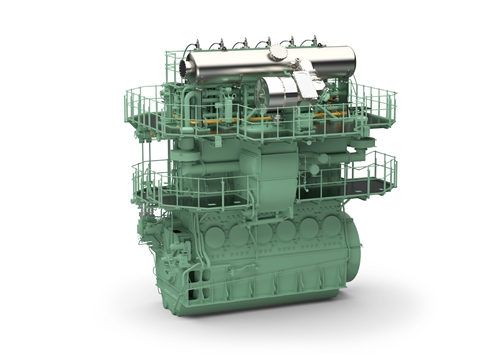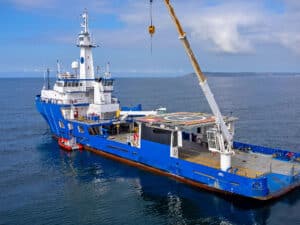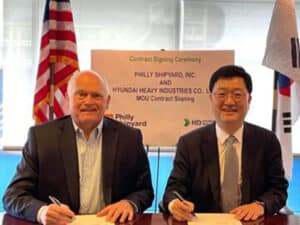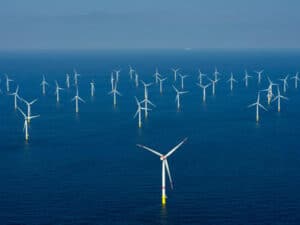
CMA CGM opts for WinGD engines to power LNG fueled box giants
Written by Nick Blenkey
WinGD X-DF engine with low-pressure gas admission
NOVEMBER 13, 2017 — CMA CGM has chosen Winterthur Gas & Diesel Ltd (WinGD) 12-cylinder X92DF engines (12X92DF) to power the nine 22,000 TEU LNG fueled containerships it is building in two Chinese shipyards (see earlier story).
The 92 cm bore, dual-fuel low-speed engines are WinGD’s largest and operate on the lean burn Otto combustion process with low-pressure gas admission and micro-pilot ignition.
The CMA CGM ships are the largest containerships thus far ordered and the 12X92DF engines will be the most powerful gas and dual-fuel engines ever built, rated at 63,840 kW at 80 rpm.
“Given the low NOx emissions of dual-fuel engines using lean burn combustion and the extremely low sulfur content of natural gas, by choosing our X-DF engines and LNG, CMA CGM is automatically complying with all existing and future emissions regulations,” says Volkmar Galke, General Manager of Sales at WinGD.
“With this move to LNG energy, CMA CGM is moving ahead for a greener shipping,” says CMA CGM’s Ludovic Gérard, Vice President of Owned Fleet. “We selected WinGD engines for the main propulsion on the grounds of their experience in dual-fuel engines and our positive feedback on the two-stroke Generation X engines”.
The regulations already met by the WinGD X-DF dual-fuel engines include the Iimits on NOx in Emission Control Areas (ECAs) imposed by IMO Tier III and the 0.5% limit on sulfur in fuel which will be introduced in 2020, as well as possible limits on particulates.
“The built-in efficiency of our lean-burn dual-fuel engines is also complemented by the favorable ratio of carbon-to-hydrogen in methane – the main constituent of natural gas – which mean that our X-DF engines are already low emitters of CO2 compared to liquid fueled engines,” says Galke. “Our X-DF engines are thus an excellent starting point for playing a full part in achieving the 30% improvement in overall vessel efficiency up to 2025 specified by the IMO’s Energy Efficiency Design Index (EEDI).”
WinGD says that, looking at the overall Total Cost of Ownership (TCO) of the new vessels, as well as operating expenditure (OPEX), capital expenditure (CAPEX) is also reduced because the emissions levels of WinGD X-DF engines are achieved without the need to install exhaust gas after treatment systems, and by the application of the low-pressure gas admission feature of the X-DF engines, which uses less expensive, more energy-efficient gaseous fuel compression equipment compared with low-speed dual-fuel engines requiring high pressure gas injection.
In addition, says WinGD, itsGeneration X engines feature a series of designed-in measures which target increased ease-of-maintenance. It is these aspects that have helped WinGD substantially increase its market share since the introduction of its new diesel and dual-fuel engines.
WinGD has so far received more than 75 orders for X-DF engines since their introduction to the market at the end of 2013. Besides being popular for application in LNG carriers for main propulsion, the number of orders received for cargo ships operating on LNG has increased substantially in 2017, with over 25 engine orders received in the year to date.





Leave a Reply
You must be logged in to post a comment.